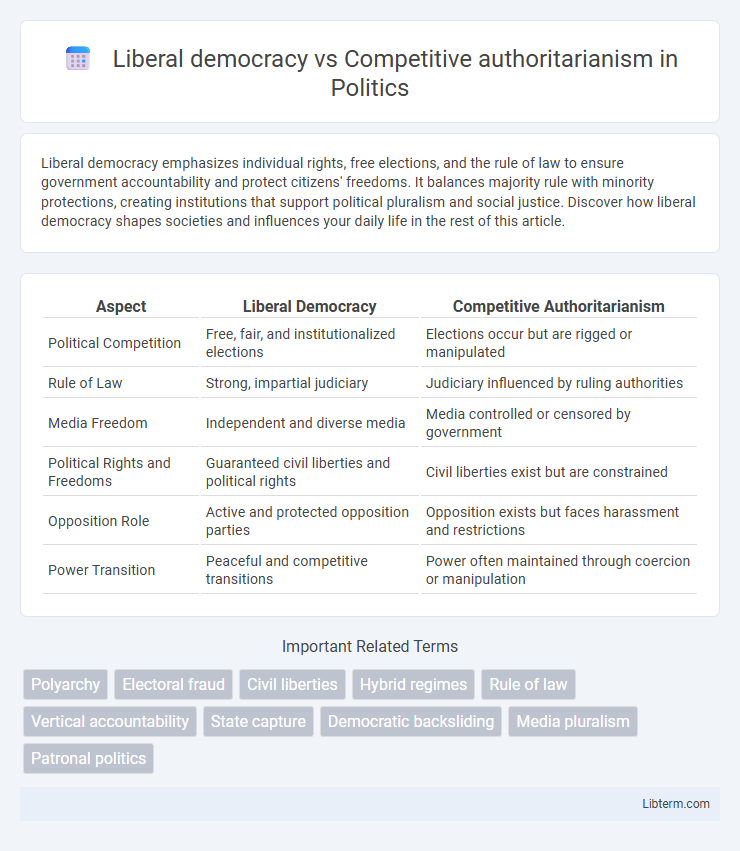Liberal democracy emphasizes individual rights, free elections, and the rule of law to ensure government accountability and protect citizens' freedoms. It balances majority rule with minority protections, creating institutions that support political pluralism and social justice. Discover how liberal democracy shapes societies and influences your daily life in the rest of this article.
Table of Comparison
| Aspect | Liberal Democracy | Competitive Authoritarianism |
|---|---|---|
| Political Competition | Free, fair, and institutionalized elections | Elections occur but are rigged or manipulated |
| Rule of Law | Strong, impartial judiciary | Judiciary influenced by ruling authorities |
| Media Freedom | Independent and diverse media | Media controlled or censored by government |
| Political Rights and Freedoms | Guaranteed civil liberties and political rights | Civil liberties exist but are constrained |
| Opposition Role | Active and protected opposition parties | Opposition exists but faces harassment and restrictions |
| Power Transition | Peaceful and competitive transitions | Power often maintained through coercion or manipulation |
Defining Liberal Democracy
Liberal democracy is defined by free and fair elections, protection of individual rights, and the rule of law that ensures government accountability and transparency. It features a vibrant civil society, independent judiciary, and multiple political parties competing on an equal footing. This system contrasts with competitive authoritarianism, where formal democratic institutions exist but incumbents manipulate them to maintain power and weaken opposition.
Understanding Competitive Authoritarianism
Competitive authoritarianism is a hybrid political regime where formal democratic institutions exist but are systematically undermined by incumbents through authoritarian practices, resulting in an uneven playing field. Unlike liberal democracies that guarantee fair elections, rule of law, and civil liberties, competitive authoritarian regimes manipulate media, restrict political opposition, and use state resources to maintain power while maintaining a facade of democracy. Key examples include Russia under Vladimir Putin and Turkey under Recep Tayyip Erdogan, where electoral competition persists but opposition parties face significant obstacles.
Historical Contexts and Origins
Liberal democracy emerged primarily in Western Europe and North America during the 17th to 19th centuries, rooted in Enlightenment ideals emphasizing individual rights, separation of powers, and rule of law. Competitive authoritarianism gained prominence in late 20th-century post-communist and developing countries, where regimes maintain nominally democratic institutions but systematically manipulate electoral and political processes to retain power. The historical divide reflects contrasting trajectories: liberal democracies evolved through gradual institutionalization of political freedoms, while competitive authoritarian regimes often arise from incomplete democratization or authoritarian resilience amidst pressures for political pluralism.
Core Institutions and Practices
Liberal democracy is characterized by well-established core institutions such as free and fair elections, an independent judiciary, and robust protections for civil liberties and political rights. Competitive authoritarianism maintains the formal trappings of democratic institutions but undermines their effectiveness through state control, election manipulation, and restrictions on opposition parties and media freedom. The core practices in liberal democracies promote genuine political competition and accountability, while in competitive authoritarian regimes, these mechanisms are compromised to preserve incumbent power.
Political Participation and Civil Liberties
Liberal democracy guarantees broad political participation through free, fair elections and protects civil liberties such as freedom of speech, assembly, and press. Competitive authoritarianism features multiparty elections but restricts genuine political competition by limiting opposition activities and curtailing civil liberties, leading to uneven playing fields. Civil society organizations in liberal democracies operate independently, while in competitive authoritarian regimes, they often face harassment, censorship, or co-optation.
Media Freedom and Information Control
Liberal democracy ensures robust media freedom, allowing independent journalism to operate without state interference, thereby facilitating transparent information flow and public accountability. Competitive authoritarianism imposes significant restrictions on media, where governments manipulate information through censorship, state propaganda, and legal pressures to suppress dissent and control public perception. The stark contrast in media environments between these regimes shapes citizens' access to truthful information and the quality of political competition.
Electoral Processes: Fairness vs. Manipulation
Liberal democracies feature electoral processes characterized by fairness, transparency, and genuine political competition, ensuring citizens have the freedom to choose their representatives without coercion. In contrast, competitive authoritarian regimes manipulate elections through tactics such as voter intimidation, media control, and electoral fraud to maintain the facade of democracy while undermining true political contestation. These manipulations obstruct free and fair elections, resulting in limited political pluralism and weakened democratic legitimacy.
Rule of Law and Judicial Independence
Liberal democracy upholds the rule of law through an independent judiciary that ensures laws are applied fairly and government powers are checked effectively. Competitive authoritarian regimes maintain a judiciary that appears autonomous but is often influenced or controlled by ruling elites, undermining true legal accountability and impartiality. The erosion of judicial independence in competitive authoritarianism frequently results in selective law enforcement and weakened protections for civil liberties.
Societal Impact and Public Perception
Liberal democracy fosters broad societal engagement through transparent institutions, accountable governance, and the protection of civil liberties, resulting in higher public trust and political stability. Competitive authoritarianism, while allowing limited electoral competition, often undermines civil rights and concentrates power, leading to public skepticism, social polarization, and potential unrest. The societal impact of these regimes is reflected in how citizens perceive legitimacy, political efficacy, and the overall health of democratic processes.
Global Trends and Future Challenges
Liberal democracy, characterized by free elections, rule of law, and protection of civil liberties, faces increasing challenges from the rise of competitive authoritarianism, where nominal democratic institutions exist but are undermined by authoritarian practices. Global trends indicate a growing number of countries adopting hybrid regimes that blend democratic and autocratic elements, complicating international efforts to promote democracy and human rights. Future challenges include addressing digital authoritarianism, disinformation campaigns, and weakening democratic norms while supporting resilient civil societies and independent institutions worldwide.
Liberal democracy Infographic

 libterm.com
libterm.com